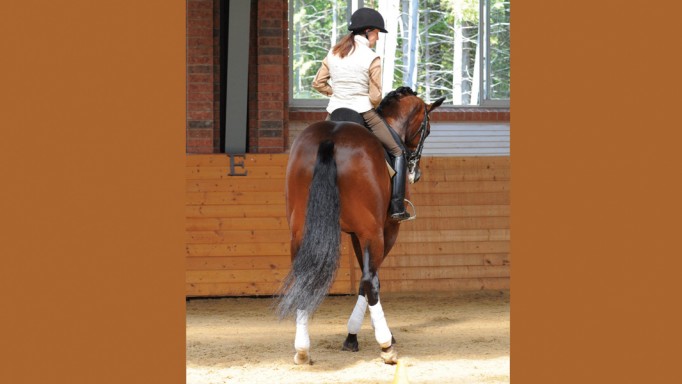“The walk pirouette, which is introduced in tests at fourth level, differs from the larger turn on the haunches in second and third level tests in one important sense: it requires collection in order to perform the movement of turning the shoulders around the haunches. As with all exercises in dressage, a movement can be only as good as the quality of gait in which it is ridden.
The most common mistake I see riders make when they collect the walk is that they slow it down, rather than getting the horse to make shorter but more active steps. Until the rider can achieve a correct, active collected walk, the walk pirouette will be quite difficult to perform.
In any of the walk work, maintaining the four-beat rhythm of the gait is key. You don’t need a horse with a perfect walk, or an expensive horse, to perform a very high-quality walk pirouette. Trained correctly, any horse and rider should be able to perform the walk pirouette for a very high mark.
A prerequisite for training the walk pirouette is that the horse should be able to perform a correct shoulder-in at the trot. An exercise I use frequently for schooling walk pirouettes is one that helps prevent one of the most common faults, when the horse becomes stuck or “blocks” with the hind legs and stops walking in rhythm, usually (but not always) with the inside hind leg.
Practise a travers-in walk on a ten-metre circle. I start by riding the horse on the circle with the haunches following in the exact path of the front legs, not tracking inside or outside. I then ask the horse to bring the haunches to the inside of the circle, while bending around my inside leg. The diameter of the circle is now smaller where the hind legs are travelling. My inside leg at the girth keeps the inside hind leg walking; my outside leg behind the girth moves the haunches in; my inside rein maintains the bend; and half-halts on my outside rein support my outside leg in keeping the haunches moving around to the inside track. I like to practise control on this circle by going in and out of the haunches-in position.
A common problem riders encounter with the haunches-in exercise is that the horse is not sensitive enough to the outside leg. If the rider uses too much leg pressure, or uses the aid for too long, the horse will actually begin to lean on the aid instead of moving away from it. The rider will also be at risk of having her weight shift to the outside as a result of the effort to push the horse with a too-strong outside leg. Carrying a whip in the outside hand is a good way to correct the horse’s lack of responsiveness. I will tap the horse immediately behind my outside leg in the rhythm of the walk at the moment the horse’s outside hind leg can be influenced by the whip aid – when it is leaving the ground.
Another exercise I often use is to ride half-pirouettes from centre line. By moving the pirouette away from the wall, the rider is less inclined to just push the horse sideways back to the rail, forgetting to use the inside leg. If the rider fails to maintain activity with the inside leg, the horse will inevitably become stuck.
Begin with riding the horse in a shoulder-fore position. I ride the half-pirouette far enough along the centre line that there is room to ride a second one in the same direction on the same line if I want to. After the half-pirouette I go back into a shoulder-fore position to reinforce the use of my inside leg aid.
It is important not to school the walk pirouettes too small. The priority should be that the horse keeps walking, as opposed to making a very small pirouette where the horse is no longer maintaining a four-beat walk rhythm. I have found that if the rider simply thinks about the horse continuing to walk with the hind legs in the walk pirouette, usually the horse will keep walking.”

